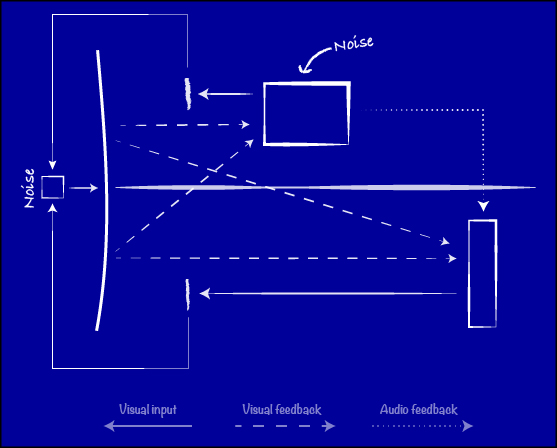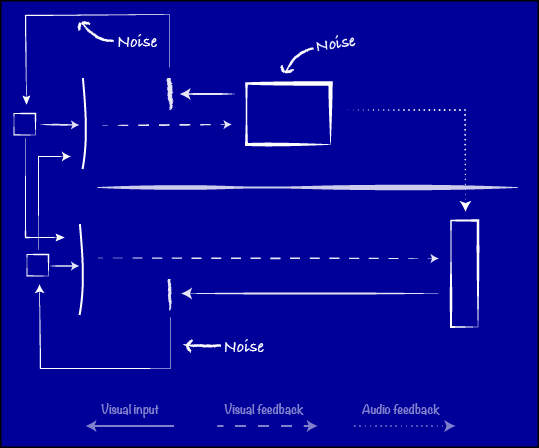Room Separation
Recapping the previous section, we have deconstructed Graham’s work as follows:
By introducing a cameras we can also take control over the feedback in the visual output. However, this also opens the possibility of adding a spatial dimension into the performance.
Time Delay Room
In this work, Dan Graham already explores the concept of delay and room separation.
The work consists of two separate rooms. Each room has a video recording camera which transmits to other room with a delay. As consequence of this, once a viewer moves from one room to the other he can see himself in the projection.
This is a kind of mind trick which plays with the current uses of surveillance.
The image below, taken from dip12, illustrates the configuration.

My Deconstruction
Following the schemas in the previous “look in to the camera”, we can also look at the delay room from the cybernetic paradigm. We see how the space dimension makes the delay situation more interesting and makes the audience wonder about the temporality of the performance.
In this configuration, there is not one closed feedback loop. This is because of the delay. In other words, the combination of the spatial and temporal dimensions disturbs the feedback loop as in cybernetic systems.
In addition to this, the audio feedback is missing. As consequence of this is closed system, feedback received does not change the whole behaviour of the audience. This configuration does not seem as a fruitful ground for Graham’s reenactment.
This shows me that the audio feedback, only noise but also making a public announcement that updates each of the systems of the audience and then potentially influences their behaviour.
In other words, the audio feedback is essential for the Performer/Audience/Mirror reenactment.
Deconstructions II

Room separation I
How can we then introduce room separation in such a way that is still meaningful to a reenactment of Graham’s performance.
A first idea is then to “extend” the mirror idea trough both spaces. From a technical perspective this would mean to centralise the visual output from both rooms.
I realised this can be achieved using streaming technology. Both cameras are connected to a central computer then this computer streams the video trough the internet.
I set up a channel in twitch.tv for this purpose; https://www.twitch.tv/rauleal
Interestingly, due to network used this already brings delay into the visual output. Also this actually allows us to not only stream to two rooms but to any number of rooms.
In try outs, audience was already perplexed by this situation. Already in part achieving the aim of this project that is to make the audience wonder about the temporality of the performance.

Room separation II
On the previous scenario, we achieve some room separation. The combination of the spacial dimension and noise in the temporal dimension already bring interesting elements to the scene that are worth exploring.
However, I still get the felling the potential of room separation is not fully used. One of the interesting elements in “Time Delay Room” is how both rooms provide independent feedback.
This idea was already suggested by dip12 as sown in the images bellow.
In an ideal situation i would like to introduce an idea of a “poppet master” which controls the streams of information behind the scenes. This would be a performance itself. Moreover, as shown in the book Remainder, it could actually serve to enhance other performances.
This lead me to look into my classmates work.
On a technical note, the integration of the video outputs has proven challenging. The conceptual idea is simple but the actual implementation is not. The issues start with finding the resources to experiment with different setups. It seems a video mixer will be needed but i am not sure yet.

Another posibility
Taken from dip12

Yet another possibility
Taken from dip12

